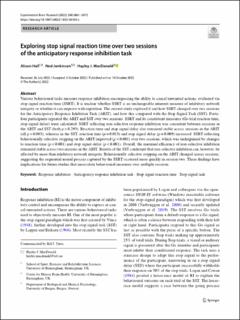| dc.contributor.author | Hall, Alison | |
| dc.contributor.author | Jenkinson, Ned | |
| dc.contributor.author | McDonald, Hayley J. | |
| dc.date.accessioned | 2022-12-05T11:43:56Z | |
| dc.date.available | 2022-12-05T11:43:56Z | |
| dc.date.created | 2022-11-14T11:28:16Z | |
| dc.date.issued | 2022 | |
| dc.identifier.issn | 0014-4819 | |
| dc.identifier.uri | https://hdl.handle.net/11250/3035849 | |
| dc.description.abstract | Various behavioural tasks measure response inhibition encompassing the ability to cancel unwanted actions, evaluated via stop signal reaction time (SSRT). It is unclear whether SSRT is an unchangeable inherent measure of inhibitory network integrity or whether it can improve with repetition. The current study explored if and how SSRT changed over two sessions for the Anticipatory Response Inhibition Task (ARIT), and how this compared with the Stop Signal Task (SST). Forty-four participants repeated the ARIT and SST over two sessions. SSRT and its constituent measures (Go trial reaction time, stop signal delay) were calculated. SSRT reflecting non-selective response inhibition was consistent between sessions in the ARIT and SST (both p > 0.293). Reaction time and stop signal delay also remained stable across sessions in the ARIT (all p > 0.063), whereas in the SST, reaction time (p = 0.013) and stop signal delay (p = 0.009) increased. SSRT reflecting behaviourally selective stopping on the ARIT improved (p < 0.001) over two sessions, which was underpinned by changes to reaction time (p < 0.001) and stop signal delay (p < 0.001). Overall, the maximal efficiency of non-selective inhibition remained stable across two sessions in the ARIT. Results of the SST confirmed that non-selective inhibition can, however, be affected by more than inhibitory network integrity. Behaviourally selective stopping on the ARIT changed across sessions, suggesting the sequential neural process captured by the SSRT occurred more quickly in session two. These findings have implications for future studies that necessitate behavioural measures over multiple sessions. | en_US |
| dc.language.iso | eng | en_US |
| dc.publisher | Springer | en_US |
| dc.rights | Navngivelse 4.0 Internasjonal | * |
| dc.rights.uri | http://creativecommons.org/licenses/by/4.0/deed.no | * |
| dc.title | Exploring stop signal reaction time over two sessions of the anticipatory response inhibition task | en_US |
| dc.type | Journal article | en_US |
| dc.type | Peer reviewed | en_US |
| dc.description.version | publishedVersion | en_US |
| dc.rights.holder | Copyright The Author(s) 2022 | en_US |
| cristin.ispublished | true | |
| cristin.fulltext | original | |
| cristin.qualitycode | 1 | |
| dc.identifier.doi | 10.1007/s00221-022-06480-x | |
| dc.identifier.cristin | 2073393 | |
| dc.source.journal | Experimental Brain Research | en_US |
| dc.source.pagenumber | 3061-3072 | en_US |
| dc.identifier.citation | Experimental Brain Research. 2022, 240, 3061-3072. | en_US |
| dc.source.volume | 240 | en_US |

